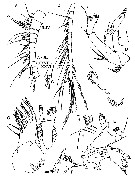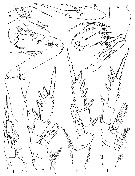|
|
 |
|
Calanoida ( Order ) |
|
|
|
Clausocalanoidea ( Superfamily ) |
|
|
|
Aetideidae ( Family ) |
|
|
|
Bradyidius ( Genus ) |
|
|
| |
Bradyidius capax Bradford-Grieve, 2003 (F) | |
| | | | | | | Ref.: | | | Bradford-Grieve, 2003 (p.96, figs.F, tab.1, 3) |  issued from : J.M. Bradford-Grieve in N. Z. J. Mar. Freshw. Res., 2003, 37. [p.97, Fig.1]. Female (from off East Cape, New Zealand): A-B, habitus (lateral and dorsal, respectively); C, rostrum (anterior view); D, idem (view slightly left of anterior); E-F, left caudal ramus (lateral and ventral, respectively); G, genital double somite ,lateral, (left side); H, idem (ventral). All illustrations are of the paratype except for D.
|
 issued from : J.M. Bradford-Grieve in N. Z. J. Mar. Freshw. Res., 2003, 37. [p.99, Fig.2]. Female: A, right A1 (ancestral segments I-XIV); B, idem (ancestral segments XV-XXVIII); C, idem terminal segment (ancestral segments XXVII-XXVIII); D, left A2; E, right Md; F, Md (masticatory edge); G, right Mx1; H, Mx1 praecoxal arthrite (posterior view); I, Mx1 outer border. All illustrations of paratype except for F, H, and I. A1 24-segmented. A2 endopod and exopod of approximately equal length; coxa and basis separate; exopod 7-segmented; most setae of endopod and exopod with dstal part annulate and lightly plumose. Md ganthobase masticatory margin with 7 multicuspid teeth that decrease in size from ventral to dorsal, a narrow long simple tooth, then a dorsal plumose seta; wide proximal part of gnathobase bearing short spinules ventrally, more distally, there are 2 rows of long spinules on anteroventral surface; basis with 2 setae; endopod segment 1 with 3 setae, one very small, segment 2 with 9 setae; exopod with 6 setae. Mx1praecoxal arthrite with 4 posterior surface setae, long posterior distal hairs, and 10 marginal spines and setae; coxal endite and basal endites 1 and 2 with 4, 4, 5, setae respectively, basal endite 1 with long spinules on anterior surface; basis and endopod segments 1-3 fused on anterior surface, demarcation between basis and endopod and endopod segments 2 and 3 visible on posterior surface; endopod with 4+4+6 setae; exopod small with 10 setae; basal exite without seta; coxal epipodite with 9 setae.
|
 issued from : J.M. Bradford-Grieve in N. Z. J. Mar. Freshw. Res., 2003, 37. [p.100, Fig.3]. Female: A, right Mx2; B, Mx2 terminal part; C, left Mxp; D, Mxp basis terminal part and endopod segment 2; E, Mxp terminal part of coxa and proximal part of basis; F, P1 (anterior); G, P2 (posterior); H, P3 (posterior); I, P4 (posterior). All illustrations of paratype except for B, D, and E. Mx2 praecoxal endite 1 with 3 spuinulose setae and one very small, articulated spine-like seta, praecoxal endite 2 with 2 spinulose setae and 1 smaller seta with proximal border heavily spinulose on one side, coxal endite 1 with 2 spinulose setae and 1 smaller seta with proximal border heavily spinulose on one side, coxal endite 2 with 2 spinulose setae and 1 slightly smaller seta with proximal border heavily spinulose on one side, basal endite 1 with 3 setae, one of them thickened and claw-like; endopod with 6 setae. Mxp syncoxa approximately same length as basis; endopod segment 1 apparently incorporated into basis, free endopod segments 2-6 with 4, 4, 3,3+1, 4 setae respectively.
|
 issued from : J.M. Bradford-Grieve in N. Z. J. Mar. Freshw. Res., 2003, 37. [p.101, Fig.4, A-D]. Female: Swimming legs, right side view of coxae. A-D, P1 to P4.
|
 issued from : J.M. Bradford-Grieve in N. Z. J. Mar. Freshw. Res., 2003, 37. [p.102, Table 3]. Comparison of three species of Bradyidius. A2 antenna; B: basis; Mn: mandible; Pd4+5: pedigerous somites 4 and 5; Re1: exopod segment 1; SR: seminal receptacles; Gns: genital double somite; f: female; m: male.
| | | | | NZ: | 1 | | |
|
Distribution map of Bradyidius capax by geographical zones
|
| | | | Loc: | | | New Zealand (SE North Island) | | | | N: | 1 | | | | Lg.: | | | (898) F: 1,85-2,2; {F: 1,85-2,20} | | | | Rem.: | hyperbenthic (depths: 299 m).This species resembles B. armatus, rakuma, and spinifer.
| | | Last update : 30/12/2014 | |
|
|
 Any use of this site for a publication will be mentioned with the following reference : Any use of this site for a publication will be mentioned with the following reference :
Razouls C., Desreumaux N., Kouwenberg J. and de Bovée F., 2005-2024. - Biodiversity of Marine Planktonic Copepods (morphology, geographical distribution and biological data). Sorbonne University, CNRS. Available at http://copepodes.obs-banyuls.fr/en [Accessed November 21, 2024] © copyright 2005-2024 Sorbonne University, CNRS
|
|
 |
 |






